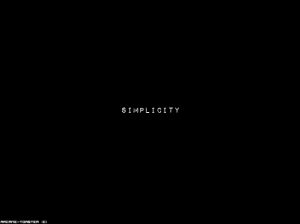 I thought it was Steve Jobs who was responsible for the above quote but it seems that he might have stolen it from Leonardo Da Vinci. No matter – it perfectly sums up Steve Jobs’ design philosophy and it’s something that I have striven for in the development of my Wagon Wheel Way Operating System. I think that too many “experts” over complicate things these days and as a consequence those seeking enlightenment from their teachings are hard put to distinguish the wood from the trees.
I thought it was Steve Jobs who was responsible for the above quote but it seems that he might have stolen it from Leonardo Da Vinci. No matter – it perfectly sums up Steve Jobs’ design philosophy and it’s something that I have striven for in the development of my Wagon Wheel Way Operating System. I think that too many “experts” over complicate things these days and as a consequence those seeking enlightenment from their teachings are hard put to distinguish the wood from the trees.
It’s always fascinating to note what part of a presentation really resonates with an audience. At a recent presentation of the WWW I was talking about Leadership, which the initiated will know is the third requirement to achieve “execution to die for”. I made the point that Leadership is one of those topics about which millions of words have been spoken and written over thousands of years yet despite our ever increasing knowledge of the subject I see no evidence to support the hypothesis that the standard of leadership has risen – in fact I think it’s gone in the opposite direction for reasons that I won’t go into here.
So when I get to Leadership, I read out a selection of the traits of the Leader and Non-leader that appear in my book. I didn’t come up with them – they are the inspiration of Robert Townsend who penned them in his second book – Further Up the Organisation – that was published in 1984. For the benefit of Gen Y and some Gen X readers, Robert Townsend was the CEO of Avis whose advertising made it a virtue of being No.2 to Hertz – “We’re Number 2 so we try harder”.
I reproduce the selection below.
|
Leader |
Non-leader |
| A coach appealing to the best in each person: open door: problem-solver and advice giver; cheerleader | Invisible – gives orders to staff – and expects them to be obeyed |
| Thinks of ways to make people more productive; more focused on organisational goals; how to reward them | Thinks of personal rewards, status, and how he or she looks to outsiders |
| Tough – confronts nasty problems | Elusive – the artful dodger |
| Focused to the point of monomania on the organisation’s values and objectives | Unfocused – except on self |
| Gives credit to others | Takes credit – complains of lack of good people |
| Prefers eyeball to eyeball instead of memos | Prefers memos, long reports |
| Knows people’s names | Doesn’t know people’s names |
| Gives honest, open feedback | Information flows one way – into his or her office |
| MBWA (Manages By Wandering Around) | No MBWA |
| Honest under pressure | Improvises, equivocates |
| Admits own mistakes: comforts others when they admit theirs | Never makes mistakes; blames others; starts witch-hunts to identify culprits |
| Available | Hard to reach from below |
| Good listener | Good talker |
| Knows when and how to fire people | Ducks unpleasant tasks |
| Knows the business and the kind of people that make it tick | They’ve never met him or her |
| Has respect for all people | Thinks blue collars and pink collars are lazy, incompetent ingrates |
| Consistent and credible to the troops | Unpredictable – says what he thinks they want to hear |
| Delegates whole important jobs | Keeps all final decisions |
As soon as I start to read a selection of the above, the murmurs of approval and head nodding give way to nervous laughter and at the end of the presentation, people come up to me and ask for a copy of the list. What appeals to them – and me – is that Townsend simply contrasted the behaviour of the Leader and Non-leader – no psychometrics, no theories, no justification, no references. When I’ve finished with my selection I quote what Townsend wrote underneath his table. “You now know more about leaders and leadership than all the combined graduate business schools inAmerica”.
I started this post with the quote that “simplicity is the ultimate sophistication”. When I used it in one presentation, one member of the audience said: “It reminds me of what Stephen Covey said – principles are the simplicity on the far side of complexity.” That’s exactly right! I wonder for how long Townsend thought about, observed and analysed leadership before he was able to distil his findings into these simple principles of behaviour?

